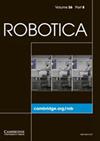基于决策树和随机森林工作空间模型的四足机器人步态规划生成器优化设计
IF 2.7
4区 计算机科学
Q3 ROBOTICS
引用次数: 0
摘要
腿式机器人在未知地形上行走时,步态轨迹的实时规划具有一定的挑战性。为了实现四足机器人更高效、更快的运动控制,本文提出了一种基于机器人腿部工作空间决策树(DT)和随机森林(RF)模型的优化步态规划生成器(GPG)。首先,对该嵌入式GPG的框架和相关模块进行了说明。针对GPG中使用的DT和RF描述的腿部工作空间模型,详细介绍了如何采集训练模型所需的原始数据,并提出了一种ILDE (Interpolation Labeling with Dilation and Erosion)数据处理算法。DT和RF模型训练完成后,我们对其性能进行了初步评价。然后,我们介绍了如何使用这些模型来预测基于其分布特征的空间点和腿部工作空间之间的位置关系。DT模型处理一个样本只需要0.00011 s,而RF模型可以给出预测概率。作为补充,还提到了用于GPG的PID逆运动学模型。最后,在虚拟四足机器人的实时单腿轨迹规划实验和未知地形识别仿真中对优化后的GPG进行了验证。实验结果表明,GPG在步态轨迹规划任务中处理大规模数据的速度非常快,在四足机器人控制中具有一定的应用价值。本文章由计算机程序翻译,如有差异,请以英文原文为准。
Design of an optimized gait planning generator for a quadruped robot using the decision tree and random forest workspace model
Abstract Real-time gait trajectory planning is challenging for legged robots walking on unknown terrain. In this paper, to realize a more efficient and faster motion control of a quadrupedal robot, we propose an optimized gait planning generator (GPG) based on the decision tree (DT) and random forest (RF) model of the robot leg workspace. First, the framework of this embedded GPG and some of the modules associated with it are illustrated. Aiming at the leg workspace model described by DT and RF used in GPG, this paper introduces in detail how to collect the original data needed for training the model and puts forward an Interpolation Labeling with Dilation and Erosion (ILDE) data processing algorithm. After the DT and RF models are trained, we preliminarily evaluate their performance. We then present how these models can be used to predict the location relation between a spatial point and the leg workspace based on its distributional features. The DT model takes only 0.00011 s to process a sample, while the RF model can give the prediction probability. As a complement, the PID inverse kinematic model used in GPG is also mentioned. Finally, the optimized GPG is tested during a real-time single-leg trajectory planning experiment and an unknown terrain recognition simulation of a virtual quadrupedal robot. According to the test results, the GPG shows a remarkable rapidity for processing large-scale data in the gait trajectory planning tasks, and the results can prove it has an application value for quadruped robot control.
求助全文
通过发布文献求助,成功后即可免费获取论文全文。
去求助
来源期刊

Robotica
工程技术-机器人学
CiteScore
4.50
自引率
22.20%
发文量
181
审稿时长
9.9 months
期刊介绍:
Robotica is a forum for the multidisciplinary subject of robotics and encourages developments, applications and research in this important field of automation and robotics with regard to industry, health, education and economic and social aspects of relevance. Coverage includes activities in hostile environments, applications in the service and manufacturing industries, biological robotics, dynamics and kinematics involved in robot design and uses, on-line robots, robot task planning, rehabilitation robotics, sensory perception, software in the widest sense, particularly in respect of programming languages and links with CAD/CAM systems, telerobotics and various other areas. In addition, interest is focused on various Artificial Intelligence topics of theoretical and practical interest.
 求助内容:
求助内容: 应助结果提醒方式:
应助结果提醒方式:


